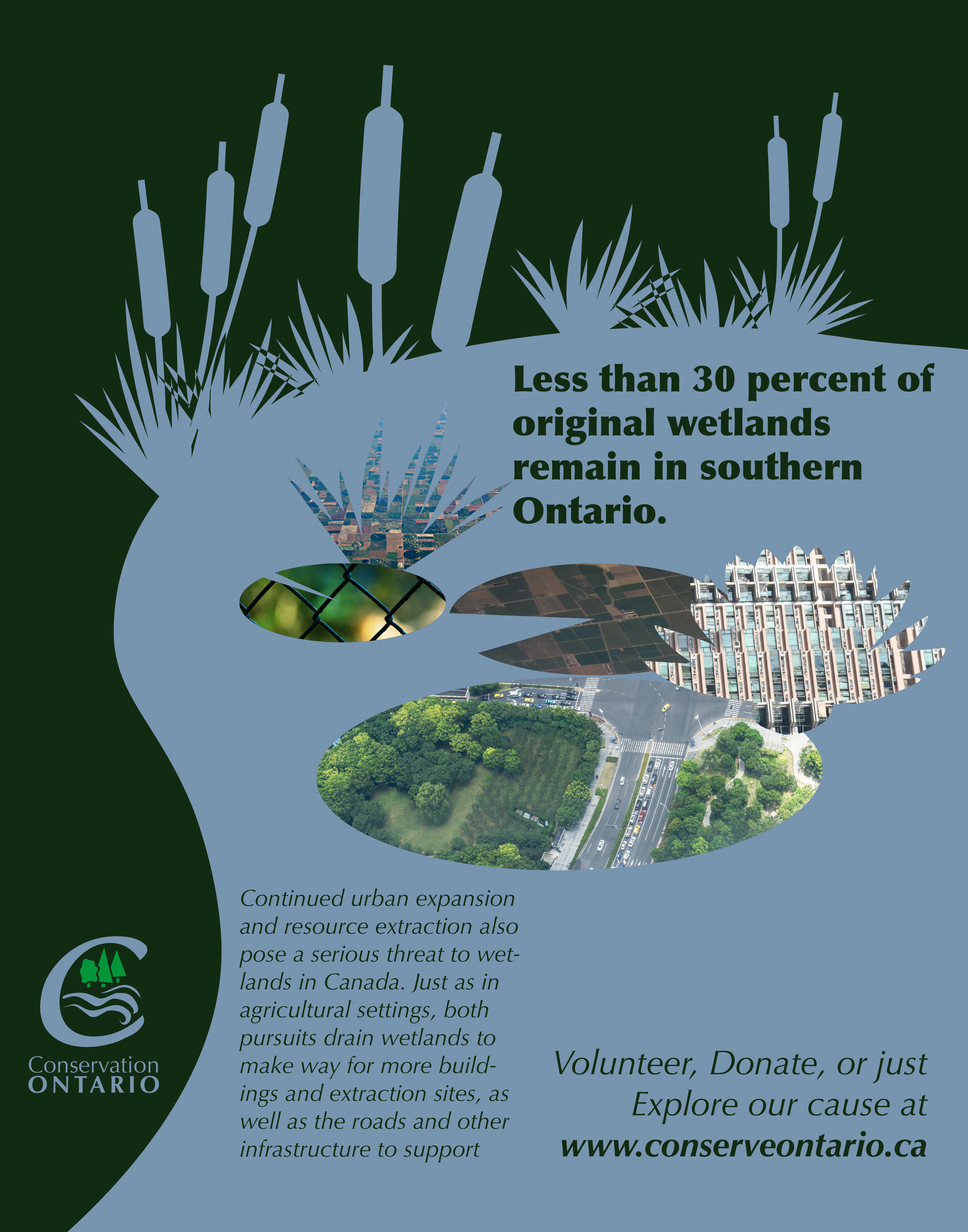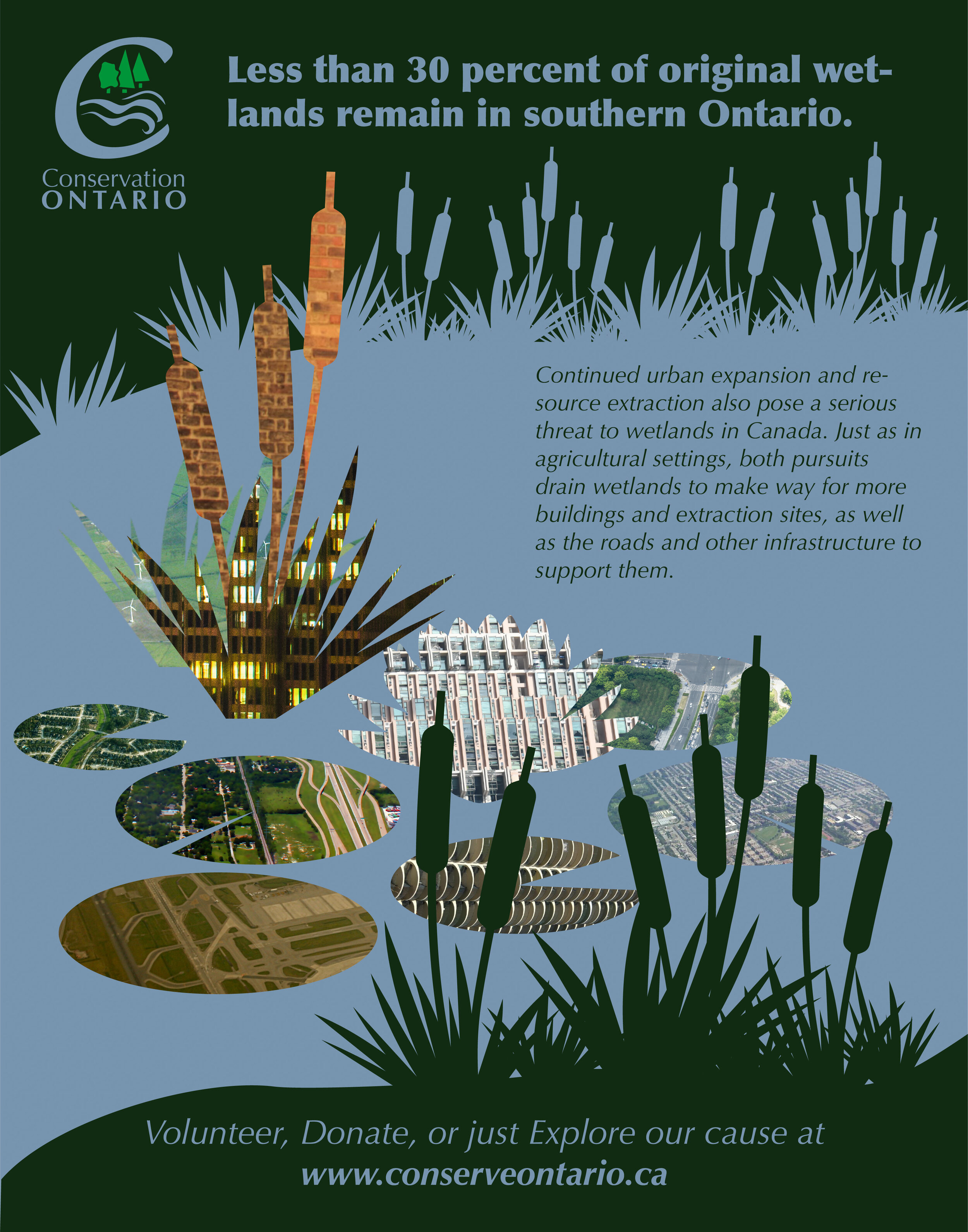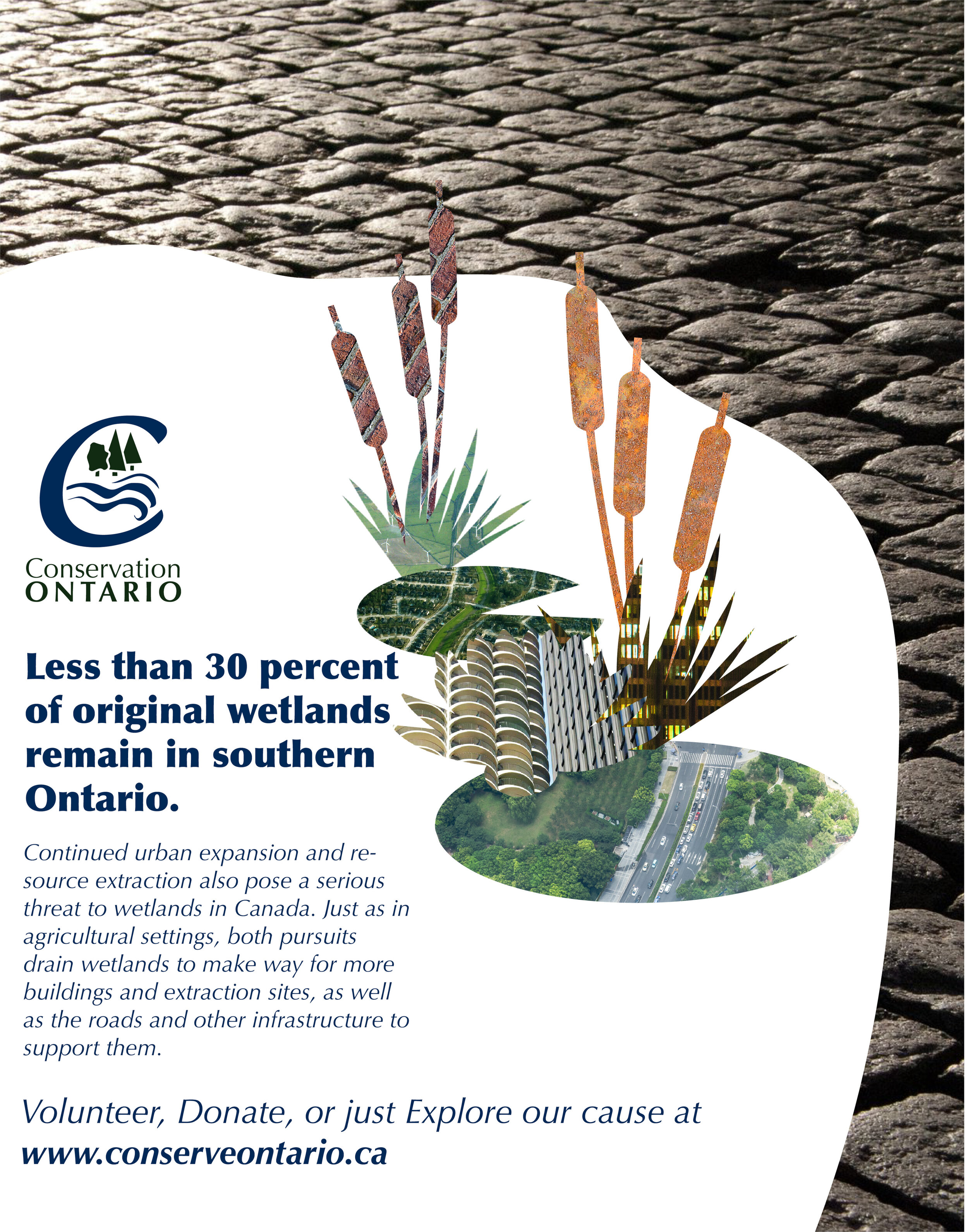Environmental Cause Poster
An exercise in visual metaphor
Strategic Brief
Conservation Ontario is a non-profit organization which seeks to establish conservation areas by purchasing land which will remain as undeveloped habitats. The most at-risk areas are often high in property value and pose a significant development opportunity for commercial, residential, or industrial constructions. Conservation Ontario must convince the residents of Ontario that this land is more valuable as an undeveloped natural area.
Project Objectives
Create a poster for a non-profit organization which uses impactful imagery to metaphorically represents the central motive of the organization.
Description of Product or Service
Design an original poster which clearly demonstrates the objectives above.
Target Audience
The primary targets are adults with disposable income. This poster seeks to impact those who have concern for the environment, take steps to reduce their ecological footprint, and regularly enjoy outdoor activities. These people will be educated, and have significant knowledge about environmentalism in general, but might be ignorant about wetlands.
Competition
Other environmental conservation efforts may have more overt impact on the viewer’s day-to-day habits. The audience may only consider donating to a limited number of causes each month. Conservation Ontario must make efforts to grab attention away from other non-profit fundraising programs.
Product Considerations
The poster will be printed at 11”x17” in full colour.
Creative Considerations
The key focus of the poster is a single factual statement. This fact is attention-grabbing and also summarizes the issue which the non-profit seeks to remedy. The secondary focus is the illustrative element which metaphorically reinforces the message. Further information will be presented in a brief paragraph summarizing the goals of Conservation Ontario. A call to action section will appear as a final focal point. Lastly, the organization’s logo will appear in a small but recognizable format.
Key Message
Wetlands are an overlooked region that has an unexpected level of biodiversity and also contributes heavily to freshwater management. If left unprotected, urban sprawl would eagerly overtake these regions, causing a variety of negative outcomes including uncontrollable flooding and species extinction. Primarily, these areas should be revered for their biodiversity and natural beauty.
Problem Statement
State the problem as you currently understand it
Urban sprawl and other developments threaten to overtake wetland areas, which would have wide-reaching implications for the ecosystem.
Describe an ideal future state
Citizens voluntarily fund the efforts of Conservation Ontario and its partners to purchase wetlands and other green spaces for the purpose of keeping them undeveloped. The conservation of the
analyze, edit, then combine the two previous points into a problem statement
Wetland conservation is a crucial component of the ongoing human effort to live in harmony with nature while also living in a heavily urbanized society.
Current State
Who/What does it affect
Anyone who resides in Southern Ontario is living among watershed features such as wetlands. These people must actively make efforts to retain the integrity of these environmental features.
Who/What does it not affect
People living far from freshwater biomes have no direct impact on the wetlands of Ontario. Also, those who live far from urbanized areas are less affected by the encroaching urban sprawl which threatens to overtake potential conservation areas.
Where/When is it
Wetlands specifically exist on flat areas near freshwater lakes and the rivers which feed into them. Wetlands become especially significant during heavy rain periods when flooding becomes a risk. The wetlands exist as sponges helping to absorb rising water, keeping human construction safe.
Where/When is it not
Areas of Canada which are far from freshwater bodies and mountainous and dry are unaffected by the need for wetland conservation. Wetlands also become less impactful during the winter when residents of southern Ontario are less likely to partake in outdoor activities which might bring them in contact with wetlands.
Ideal State
Same as above, but applied to the ideal future state
Wetlands will be appreciated for their function and natural beauty, and as such there will be legal restrictions on all new constructions which reduce human impact on these biomes. Residents of the watershed region will take pride in the diverse wildlife of the area, and these features will increase the property value of nearby constructions.
Statement 1
Wetlands are an overlooked region that has an unexpected level of biodiversity and also contributes heavily to freshwater management. If left unprotected, urban sprawl would eagerly overtake these regions, causing a variety of negative outcomes including uncontrollable flooding and species extinction.
Statement 2
This poster will serve to raise awareness of the importance surrounding this diverse ecosystem which surrounds many of us in Ontario. Urban development threatens to overtake this local environmental feature. Wetlands must have representation to demonstrate its value in the face of growing land value.
Concept Statement
Working to conserve the wetlands of Ontario
The great lakes region of North America is one of the most ecologically diverse areas in the world, yet it is often overlooked when compared to more famous densely populated natural biomes such as the tropical rainforest or coral reef. The lakes themselves only represent one part of a large freshwater system.
Wetlands exist all around southeastern Ontario, and their stability directly relates to the overall health of the region. Preserving these areas can obviously improve the condition of local wildlife, but there are numerous benefits to human health and the economy. They are rarely considered by most people, and many see them as a marshy impenetrably bog. These areas are not very conducive to classic human pastimes. People do no swim in marshes, and they are not good for water-skiing. The wetlands are easily dismissed or ignored.
A watershed is an area of land that drains rain water or snow into one location such as a stream, lake or wetland. These water bodies supply our drinking water, water for agriculture and manufacturing, offer opportunities for recreation and provide habitat to numerous plants and animals. Unfortunately, various forms of pollution, including runoff and erosion, can interfere with the health of the watershed.
Biomes such as these must be actively protected. Organizations must make great efforts to protect these areas from development. People must be made aware of the wide array of animals which live in the wetlands. The unique untainted beauty of these wild areas should easily engage the environmentally conscious citizens of the area.
Design Specifics
The aim of this poster is to highlight one small aspect of the wetland biome. Demonstrating the dense biodiversity of such a mundane-seeming natural feature will help viewers admire the natural features which surround their daily life.
The main illustrative element of this poster will be a silhouetted foreground depicting some of the common flora and fauna of Ontario’s wetlands. The background will depict a city skyline in a similar silhouette. Between the foreground and background will be an empty white field in the center of the poster. Within this central white area will be set the main text elements. This white area will represent the presence of water within the scene described by the positive foreground and background elements. This area will feature wildlife imagery implied through silhouette along the shoreline, using the principle of closure to form the abstract shapes into recognizable forms.
Facts
Collectively, Conservation Authorities own and protect a total of 150,000 hectares, including forests, wetlands, areas of natural and scientific interest, recreational lands, natural heritage and cultural sites, as well as, land for flood and erosion control.
At the current rate, an additional 260,000 acres (1,070 km2) of rural land in southern Ontario will be urbanized by 2021.
Less than 30 percent of our original wetlands remain in southern Ontario. In the Niagara and Greater Toronto Area, that number drops to 10 percent.
Wetlands are critical to water filtration, flood retention, erosion control, carbon storage, nutrient cycling and groundwater recharge. They also provide habitat for specialized wildlife communities. Over 20 percent of the province’s species at risk are directly dependent on wetland habitats.
Wetlands enhance landscape resilience to many of the anticipated impacts of climate change, including flooding, drought and the loss of biodiversity. They play a critical role in carbon storage.
By undervaluing wetlands, Canadians have allowed many of them to be destroyed. In the worst cases, such as some areas on the prairies, as much as 90% of our wetlands have disappeared.
Continued urban expansion and resource extraction also pose a serious threat to wetlands in Canada. Just as in agricultural settings, both pursuits drain wetlands to make way for more buildings and extraction sites, as well as the roads and other infrastructure to support them. These efforts have supported communities, but they have also harmed them by removing our natural defense systems: wetlands.
Rationale
Concept
Create a provocative poster which encourages the audience to become informed and donate time and/or money to the cause. Use colours which relate to the corporate identity of the non-profit organization itself, i.e. blue and green. Use a friendly reassuring typeface which also carries a sense of trustworthy authority.
Arrange these elements around a central image which metaphorically reinforces the crux of the issue.
Application
This poster starts with a provable fact about the rate of wetland decline as a result of urban sprawl. This is followed by a brief paragraph further explaining this rate of decline and its relationship to human development. The call to action informs the viewer where they can find further information or donate money if they choose to.
All of the type elements are rendered in varying weights and sizes of Optima. This font appears in many official signs and documents, especially in the education field. The letterforms have curvaceous dynamism but are fundamentally serious and sober. Optima is featured heavily in the identity of the many national and provincial parks across Canada.
The main imagery shows the silhouetted forms of plants familiar to wetland areas. Instead of the familiar colours, these forms are filled with cropped photographs depicting images of human development. The metaphor is simple – replacing natural areas with urban sprawl is absurd.




